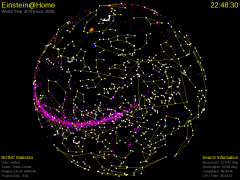Einstein@Home:屏幕保护
Einstein@Home 的屏保
The Einstein@Home Screensaver has a number of elements related to current efforts to detect gravitational radiation from periodic sources such as pulsars. The primary element of the screensaver is a rotating celestial sphere showing the known constellations, along with the current zenith positions of three gravity wave detectors. The positions of the detectors relative to the stars changes periodically over a 24 hour period. If you went to one of the detector sites, the stars visible directly overhead at any time are the same ones that appear next to the detector on your screensaver. (This assumes of course that your computer's time and timezone are correctly set!) Also shown are the positions of the known pulsars and supernovae remnants, and a marker indicating the positions being searched as the calculations proceed. When the graphics are shown in a separate window (not as a screensaver) the user can control the display with the mouse and keyboard.
Stars and Constellations
The rotating sphere shows the major stars of the constellations. You may have trouble at first recognizing some of the constellations; they will be backwards from what you are accustomed to because you are viewing them from outside the celestial sphere. You can use the mouse (as described below) to zoom to the inside of the celestial sphere, where the constellations will look like they normally do in the night sky.
Einstein@Home 屏保的内容与探测引力波的实验有很多联系:比如 LIGO 和 GEO600 的位置、已知的引力波发射体和你的计算机当前正在分析的天空区域。屏保的主体是一个旋转的天球,天球(地心天球)是一个假想的以地球为中心的球体,然后再将星体投影在这个球体上。天球上标识出了星座的主要星体位置,但可能与你熟悉的有所不同,因为你现在是从天球外面而不是地球上观测它们。
Gravity Wave Observatories
Each of the "L" shaped markers on the starsphere represents the current zenith position (point directly upward) for one of the instruments which collects the data analyzed by Einstein@Home. The "L" shape comes from the fact that the detectors are basically very large Michelson interferometers. The orientation of the detectors is correct, but they are not to scale.
“L”型的标记表明的是两个 LIGO 观测站的天顶位置。“L”型对应于探测器的实际方位,当然,探测器并没有标记所看上去的那么大。

|
汉福 LIGO 观测站 (LHO) 美国,华盛顿,汉福,北纬46.45度,西经119.41度 拥有两套干涉仪,一套臂长为4公里,另一套为2公里。 |

|
李文斯顿 LIGO 观测站 (LLO) 美国,路易斯安娜州,李文斯顿,北纬30.56度,西经90.77度 拥有一套干涉仪,臂长4公里。 |
| GEO 600 德国,汉诺威,北纬52.24度,东经9.81度 拥有一套干涉仪,臂长600米。 |
If you have set your system clock to the correct time then the instruments will be shown in the correct relationship to the stars on the celestial sphere. If you watch over the period of a day you will see that they move around the celestial sphere once in a period of 24 hours.
如果你的系统时间设置正确,屏保中的探测器与天体位置将与现实中的相符。如果你对着屏保看一天,它们也将在24小时内围绕天球旋转一圈。
脉冲星和超新星遗迹
The purple dots represent the known pulsars, which have been detected electromagnetically. Notice that these are clustered in the plane of our galaxy (the Milky Way), predominantly toward the center of the galaxy. You may also notice two small clusters of pulsars in the celestial southern hemisphere. These pulsars are located in the large or small Magellanic Clouds.
天球上标识出了脉冲星和和超新星遗迹,因为科学家们相信它们都会发射出引力波。屏保中紫色的点表示已探测到的脉冲星(高密度、快速旋转、发射脉冲光的星体)位置。这些点分布在银河系所在的平面上,而且主要分布在银河的中心。它们很有可能就是引力波源。
The dark red dots represent the known supernova remnants. These are also clustered toward the center of the galaxy. Supernovae remnants are of particular interest for gravity wave hunters because some of these supernovae may have left behind a pulsar or spinning neutron star which might produce periodic gravity waves.
屏保中暗红的点表示已知的超新星遗迹(SNRs,超重星体爆炸后所剩下的残迹)。它们也主要聚集在银河的中心。超新星遗迹中可能还存留有脉冲星或自旋中子星,而这些都会产生引力波。
Search Marker
The orange marker shaped somewhat like a gun-sight represents the current position in the sky which is being searched. The location is also noted in the lower right corner in celestial coordinates (Right Ascension and Declination). You will see this marker move from point to point as the search progresses. Details on how we search for gravity waves coming from a particular source will be linked from here sometime in the future.
天球上一个中间画有十字的移动小圈表示的是你的计算机当前正在分析的天空区域。这个位置的坐标显示在屏保的右下角。搜寻过程中你会看到这个标记一点点地移动。
Mouse and Keyboard Controls
When the graphics are displayed in a separate graphics window (rather than as a screensaver) you can control the display with the mouse and keyboard. To zoom in or out or rotate the starsphere hold down the appropriate mouse button and move the mouse up and down or left and right.
| Action |
| zoom in or out |
| rotate the star sphere |
相关内容及图片由 Eric Myers(美国纽约州 Vassar 学院天体物理系)、David Hammer(位于美国密尔沃基的威斯康星州立大学物理系)和 Bruce Allen(位于美国密尔沃基的威斯康星州立大学物理系)提供。
参考资料
